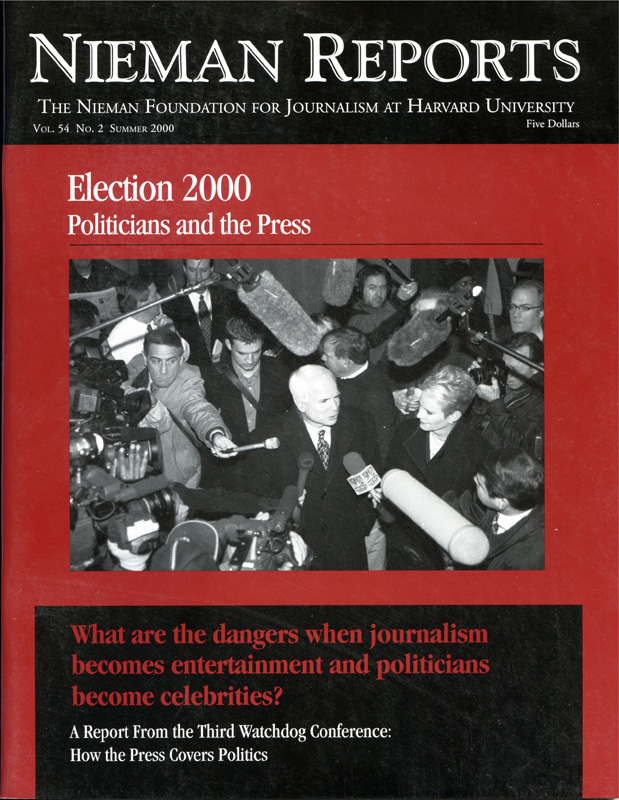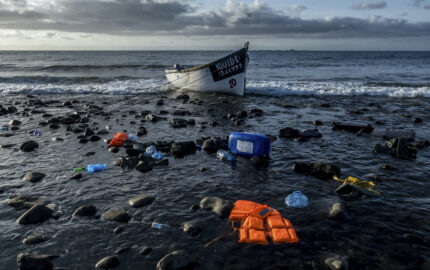
Photo by Greg Behar/U.C. Berkeley Graduate School of Journalism, Center for Photography.
By a margin of 59 percent to 34 percent, participants in Pew Center survey said they think editors care more about the opinions of politicians and other political insiders than their own audiences when deciding which stories to cover in an election. During the Watchdog Journalism Conference, several speakers explained how they make decisions about coverage.
Mike Pride, Editor, the Concord (N.H.) Monitor: “We have a lot of presidential candidates come into our area for three and four days and we attempt to cover them whenever they’re in our circulation area…. You can imagine what it would be like for our readers if we just sent a reporter out and said, ‘Write down what the candidates say, who they meet with, and what kind of interaction they have with people.’ If John McCain comes to our area for three days and talks to five or six different kinds of groups, then the kind of coverage we would be giving them would be the same story three days in a row, or basically the same kind of story.
“Now, reporters certainly can’t ignore what happens on the campaign trail. But you need to shape that campaign coverage in a way that’s going to make the most of your reporters’ access to the candidate. When John McCain came on one particular trip he was attempting to, shall we say, retool his abortion position, and this seemed like an important thing for our reporter to focus on. This was not what John McCain was focusing on when he came to talk to the Rotary Club and the veterans’ groups and the other people in town. We managed to get some access to McCain on that particular day and wrote a story that was focused almost entirely on his effort to switch his position on abortion and how that was playing with the public, by talking to the people who came to the event.
“The next day he was speaking to a veterans’ group. What we decided to focus on was his effort to fold his war hero status into his candidacy. To what degree was his candidacy going to be based on his war hero status? And how was this playing with the public? What was it about McCain’s military experience, his experience as a POW, that people might look at and say, this is what qualifies him for President? That was the focus of that day’s story. That wasn’t all that John McCain did that day. Our coverage wasn’t following him one place after another through his day.
“So that gives you an idea of the way we approach campaign coverage…. We definitely do sit back in the office and try to figure out how we ought to cover these people. We don’t sit back in the office and say we ought to send our reporters out wherever they are and write down whatever they do and put it in the paper.”
Ray Suarez, senior correspondent, “The NewsHour with Jim Lehrer”: “When a campaign is thinking heavily about whether the candidate should wear bone or khaki chinos and choosing what kind of Timberland boots the candidate is going to wear to the berry pie supper because it makes a good picture for the front page or that night’s evening news, reporters think that they will up the ante and be smarter than that and not fall for the Timberlands and the chinos and the berry pie. So they are going to ask the zinger. So campaigns then cover up more and try to control how much line they let out and what they say and how they’re going to say it.
“So you’ve got a sort of arms race of declining information going on. Speculation in the absence of information generated in frustration by reporters who don’t find campaigns communicative or real. Then in the response to that hit piece, campaigns cover up more and only let reporters talk to candidates in front of just folks, which makes them seem petty, stupid and like a pack of braying hounds. Then you see that on television and people say, ‘God, what a bunch of jerks.’ There are two sides in this dance, and they’re both busily stepping on each other’s feet. It’s not just one side or the other.”
Geneva Overholser, columnist, Washington Post Writers Group: “The abortion story is important locally and nationally, Mike. If your reporter presses him and he changes and it becomes clear why he’s changed or how much he’s changed or whatever on abortion, that’s an important national story. But you also obviously are thinking about what your readers need to know about McCain, the people who didn’t talk to him at each of those gatherings where he went. How do you balance those two needs? I think that’s part of what Congressman Hamilton was talking about when he said members of the press want to be part of policymaking. In a sense your reporters are pressing McCain because you feel that we need to know what he thinks on abortion. But that responsibility is set against what your readers just need to know broadly about McCain. Most of your readers would probably say, I’m more interested in the whole picture of things about McCain than I am in you pressing him on abortion.”
Mike Pride: “I’m trying to say if my readers had access to John McCain during the last two days in the paper, what they’ve read is McCain flip-flopping a little bit on abortion. That’s something they want to know about. That’s a very current issue, and it’s an important issue to all my readers as well as to the political process. So to me the most important issue in trying to shape this kind of coverage is access. If you can get your reporter 20 minutes with McCain to talk with him about abortion, during his campaign day in which he doesn’t have any scheduled stops at which he’s going to talk about that subject, then you can therefore advance the story. But you also find out what it is that the people he’s speaking with think about this issue and how this is going to play out in the campaign. To me, that’s really the way to do it.…
“We’re going to see John McCain 30 or 40 times during this campaign. I think we’ll be able to cover everything that he says. And I also believe very strongly that our coverage has to cover the stump speeches. The stump speeches are really important in campaign coverage. And I think they’re often overlooked. Often you read a story about inside baseball on the day that the stump speech is made. So something that we also really, really focus on is what the candidates actually say. We don’t ignore that. It’s just that if you’re going to be covering a candidate for three days in a row you’d better figure out a way to focus those stories on issues or the stories are not going to be read. And you’re not going to be doing what you’re supposed to doing, which is standing for the readers and giving them information about what matters to them.”
Gwen Ifill, senior correspondent, “The NewsHour with Jim Lehrer” and Moderator of “Washington Week in Review”: “We find ourselves in this interesting position of attempting to put the news in context. Do not think for a minute that the news you read in your newspaper or you see on your television is decided by the person you see telling it to you or the byline on the story. It’s decided by a whole set of complex factors. Geneva touched on it briefly when she talked about the corporate nature and the competitive nature of television news and certainly newspapers. Ratings are driving a lot of that. But also there’s something else driving it…. There are people of goodwill and good journalistic integrity who are attempting to tell the story more interestingly, who are attempting and sometimes failing to tell you something that you didn’t know before and put that personality in some sort of context. So that you understand a little bit more about who it is you’re talking about, not just ‘He believes these five things which we told you about yesterday.’ Let’s tell you about him or her. Sometimes we do that really clumsily. And sometimes we do it in an enlightening way. And sometimes it leads us to another story.”
On a related topic, Geneva Overholser talked about how confusion can arise in the public’s mind when the press fails to differentiate between what is reported as fact and what is integrated into the story as judgment or analysis by the writer.
Geneva Overholser: “We could certainly say it’s our responsibility to let the public know about a candidate who cut a midnight deal. Those are all pieces of information that we have decided we can and need to give readers in order to help them really understand a candidate. My problem with that is when we start putting it in the lead instead of saying first here’s what happened. I can’t tell you the number of times when I was the Ombudsman at The Washington Post, I’d have readers call and say, ‘I had to go to the jump to see what this bill said.’ I mean, [the story says] it got introduced at the midnight hour in response to this kind of debate because this candidate has this problem or this politician has this problem. Readers don’t find out what it is or what it might do for them until they get to the jump.
“Part of what we need to do is recognize that readers don’t understand that we’ve changed these rules about whether we separate news and opinion. We’re not nearly as clear as we sometimes think we are about labeling an analysis story. We sort of do it oddly in the [Washington] Post and the [New York] Times…. I ask you to think about this when you look at the coverage. You’ll see an analysis slug on some stories that are less egregiously opinionated, in my view, than on some of the straight news stories. We need to give people the facts and we need to tell them what we, quote, really think is going on. But we need to separate the two, or at the very least put the facts up higher and our opinion about what’s behind this lower in the story.”



